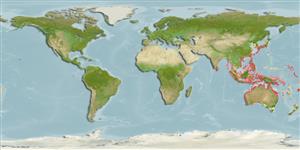Klassifizierung / Names
Namen | Synonyme | Catalog of Fishes(Gattung, Arten) | ITIS | CoL | WoRMS | Cloffa
Environment: milieu / climate zone / depth range / distribution range
Ökologie
seewasser riff-verbunden; tiefenbereich 0 - 10 m (Ref. 93839). Subtropical
Western Pacific: subtropical, from southern Japan to Taiwan, then from subtropical Australia to New Caledonia and the Kermadec Islands.
Size / Gewicht / Alter
Maturity: Lm ? range ? - ? cm
Max length : 14.0 cm TL Männchen/unbestimmt; (Ref. 559)
Rückenflossenstacheln (insgesamt): 8; Rückenflossenweichstrahlen (insgesamt): 9; Afterflossenstacheln 2; Afterflossenweichstrahlen: 8. Distinguished by having the following characteristics: dorsal fin rays VII-I, 9; anal fin rays II, 8; pectoral fin rays 15; pelvic fin rays I, 5; pored lateral line scales 24; predorsal scales 3; circumpeduncular scales 12; body pinkish brown, with four dark brown stripes on lateral surface of body; third stripe posteriorly not reaching to a black spot on caudal fin base; caudal fin base spot subequal in size to pupil diameter (Ref. 93839).
Commonly occurs in rocky areas near shore and abundant on ledges. Solitary but pair off during breeding. Mouth brooding is done by the male. Nocturnal species (Ref. 7300).
Life cycle and mating behavior
Geschlechtsreife | Fortpflanzung | Ablaichen | Eier | Fecundity | Larven
Mouthbrooders (Ref. 240). Distinct pairing during courtship and spawning (Ref. 205).
Randall, J.E., G.R. Allen and R.C. Steene, 1990. Fishes of the Great Barrier Reef and Coral Sea. University of Hawaii Press, Honolulu, Hawaii. 506 p. (Ref. 2334)
IUCN Rote Liste Status (Ref. 130435)
Bedrohung für Menschen
Harmless
Nutzung durch Menschen
Mehr Information
ReferenzenAquakulturAquakultur ProfilZuchtlinienGenetikElectrophoresesVererbbarkeitKrankheitenVerarbeitungNutrientsMass conversion
PartnerBilderStamps, Coins Misc.LauteCiguateraGeschwindigkeitSchwimmstilKiemenoberflächeOtolithsGehirngrößeSehfähigkeit
Tools
Zusatzinformationen
Download XML
Internet Quellen
Estimates based on models
Preferred temperature (Ref.
123201): 20 - 28.9, mean 27.6 °C (based on 1621 cells).
Phylogenetic diversity index (Ref.
82804): PD
50 = 0.5000 [Uniqueness, from 0.5 = low to 2.0 = high].
Bayesian length-weight: a=0.01413 (0.00807 - 0.02472), b=3.17 (3.02 - 3.32), in cm total length, based on LWR estimates for this species & Genus-body shape (Ref.
93245).
Trophic level (Ref.
69278): 3.6 ±0.56 se; based on food items.
Generation time: 0.5 ( na - na) years. Estimated as median ln(3)/K based on 1
growth studies.
Widerstandsfähigkeit (Ref.
120179): hoch, Verdopplung der Population dauert weniger als 15 Monate. (Preliminary K or Fecundity.).
Fishing Vulnerability (Ref.
59153): Low vulnerability (10 of 100).
Nutrients (Ref.
124155): Calcium = 132 [44, 409] mg/100g; Iron = 1.72 [0.67, 4.15] mg/100g; Protein = 19.5 [17.8, 21.2] %; Omega3 = 0.153 [0.042, 0.558] g/100g; Selenium = 28.6 [6.6, 111.8] μg/100g; VitaminA = 9.24 [1.28, 80.05] μg/100g; Zinc = 1.73 [0.80, 3.44] mg/100g (wet weight);
